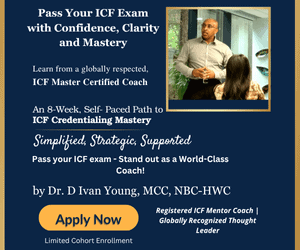For any coach wanting to earn media coverage, knowing how to use research to support your topic or take on a timely issue is an essential skill. Using the right data to back up your key point can help you present as the informed and authoritative expert you are. Best of all, you do not have to go it alone. The International Coaching Federation (ICF) offers a rich library of original research on hot topics that you can use to inspire reporters and draw insights that build their interest.
ICF Research
ICF provides numerous studies such as the Global Coaching Study, Global Consumer Awareness Study and Building a Coaching Culture, just to name a few.
The Global Coaching Study, commissioned by ICF and conducted by PwC Research, offers a comprehensive survey of the coaching industry, and explores topics such as industry size and revenue, the business and practice of coaching and offers perspectives on industry trends. ICF will release the results of the 2020 Global Coaching Study on September 10, 2020.
The Global Consumer Awareness Study, another collaboration between ICF and PwC, taps into the minds and motivations of consumers to help coaches better understand current and prospective clients and market their coaching services accordingly.
The Building a Coaching Culture research suite is the result of a research partnership between ICF and the Human Capital Institute (HCI). This research explores the value organizations and businesses realize from creating a coaching culture. In most cases, offering employees at all levels the opportunity to grow their skills, enhance their skills and reach their professional goals produces meaningful benefits for the organization. Key topics, such as change management in the workplace are on the media radar, so data from this study can capture attention.
To best use the insights derived from these studies start by familiarizing yourself with their contents and prioritizing the most recent studies available. Anything more than a few years old will be a hard sell for reporters, but trends or changes in behavior could be of great interest to them.
ICF does much of the heavy lifting of data assessment by providing fact sheets that call out the highlights from the research which makes it easier to grab key data points from the studies.
Leveraging Key Data
Once you have found the data to support your key points, consider the data within the framework of your email by detailing your topic or angle, also called a “pitch”. Providing a case study is also valuable because it provides a real-world story behind the numbers. Case studies bring data to life in a way that makes it personal for the reader.
Remember, you don’t want to drown them with too much data. Reporters will value your pitch if it helps them to learn more and ask good questions. There is no need for the pitch to tell the entire story. You should only focus on what’s most relevant and compelling. A good rule of thumb is to include one to three data points, so you are not overwhelming the reporter with information.
A Note on Accurate Phrasing
It is important when drawing data from research that you not only stick to accurate numbers but also are careful with your phrasing.
For example, if a survey reports that respondents answered a question about using coaching services as 9% “always”,18% “often” and 23% “sometimes” you must be careful of how you summarize. It is not an accurate portrayal to rephrase this as, “50 percent of respondents identified as using coaching services.”
Rather, an appropriate portrayal would be to say, “50 percent of respondents identified as ‘always,’ ‘often,’ or ‘sometimes’ using coaching services.”
It may seem cumbersome, but survey language holds nuance and can impact responses. For this reason, maintaining language accuracy in how you report the results is important.
It’s Time to Pitch
Before sending your pitch, you should review your email language. Check it again to ensure the message is clear, the data is portrayed accurately and ensure that you have not overloaded the reporter with too much information. When you finish editing and give it one more check, it’s time to hit send.
With this compelling combination of expertise and research, you will have a powerful combination that reporters are likely to pursue.
Disclaimer
The views and opinions expressed in guest posts featured on this blog are those of the author and do not necessarily reflect the opinions and views of the International Coach Federation (ICF). The publication of a guest post on the ICF Blog does not equate to an ICF endorsement or guarantee of the products or services provided by the author.
Additionally, for the purpose of full disclosure and as a disclaimer of liability, this content was possibly generated using the assistance of an AI program. Its contents, either in whole or in part, have been reviewed and revised by a human. Nevertheless, the reader/user is responsible for verifying the information presented and should not rely upon this article or post as providing any specific professional advice or counsel. Its contents are provided “as is,” and ICF makes no representations or warranties as to its accuracy or completeness and to the fullest extent permitted by applicable law specifically disclaims any and all liability for any damages or injuries resulting from use of or reliance thereupon.
Authors
Post Type
Blog
Audience Type
Experienced Coaches, External Coaches, ICF Chapter Leaders, Internal Coaches, Mentor Coaches, New Coaches, Professional Coaches, Team and Group Coaches
Topic
Business Development
Related Posts
The Executive Coaching Blueprint: Positioning, Pricing, and Performance
Transitioning from corporate to coach can feel like uncharted territory for many…
Why Coaches Need Other Coaches
Setting the Foundation When you’re learning about the field of coaching while…
Expanding Coaching Possibilities With the Coaching Spectrum Framework™
When I discovered coaching 14 years into my career as an occupational…








